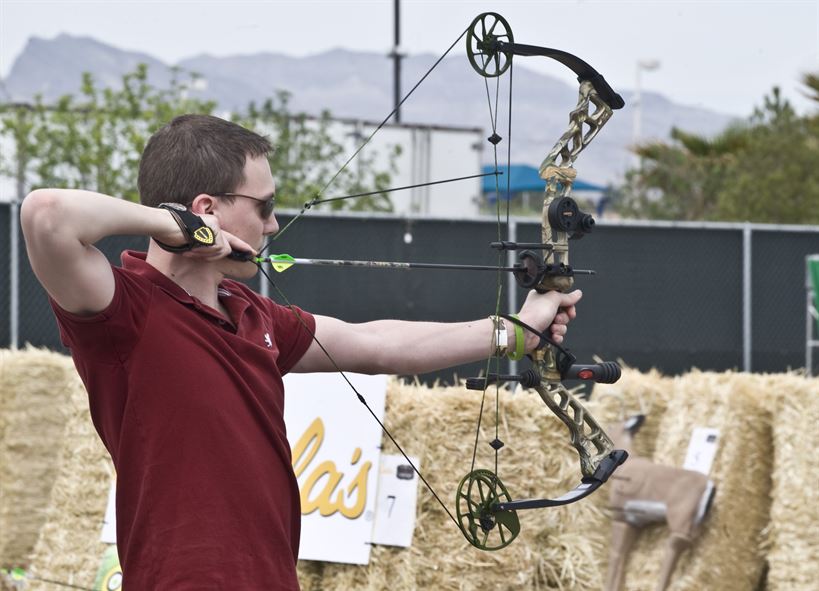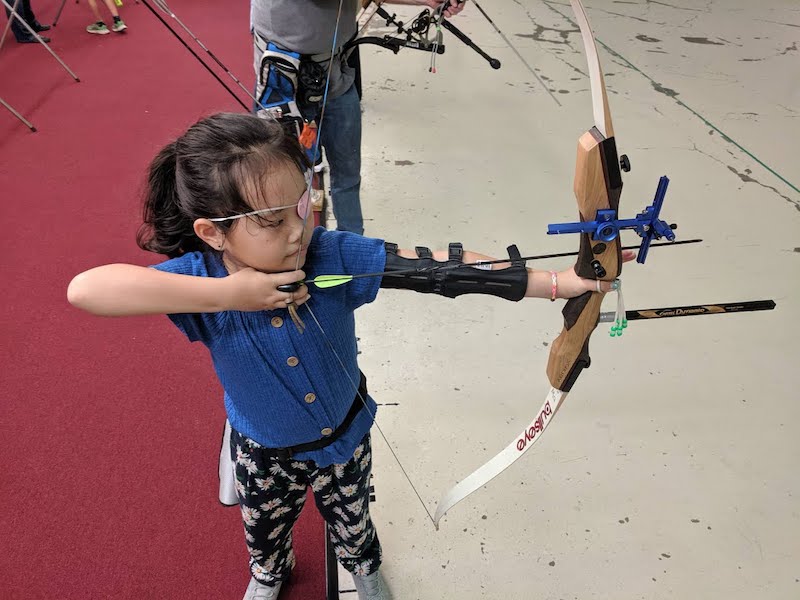
So you’re interested in learning how to practice archery? Well, you’ve come to the right place! If you’ve ever dreamed of channeling your inner Katniss Everdeen or Legolas, then look no further. In this article, we will guide you on your journey to becoming an archery aficionado. Whether you’re a complete beginner or have some experience, we’ll cover everything from choosing the right equipment to mastering the perfect form. So grab your bow and arrows, and let’s get started on this exciting adventure together!

Choosing the Right Equipment
When starting your archery journey, it’s important to choose the right equipment that suits your needs and preferences. One of the first things to consider is determining your dominant eye. This will help you determine which hand you should use to hold the bow, also known as your bow hand. Your dominant eye is the one that your brain prioritizes when processing visual information, and it’s important to align this with your shooting hand for better accuracy and precision.
Once you’ve determined your dominant eye, you can move on to selecting the right bow type. There are several types of bows to choose from, including recurve bows, compound bows, and traditional longbows. Each type has its own advantages and disadvantages, so it’s important to research and try out different bows to find the one that feels most comfortable and suitable for you.
Next, you’ll need to choose the proper draw weight for your bow. The draw weight refers to the amount of force required to pull back the bowstring. It’s important to select a draw weight that you can comfortably handle, as choosing one that is too heavy can lead to poor form and potential injuries. Starting with a lower draw weight and gradually increasing as your strength and skill improve is recommended.
Investing in quality arrows is another essential aspect of choosing the right equipment. Arrows come in different materials, lengths, and weights, and selecting the right ones can greatly impact your shooting performance. It’s important to choose arrows that are compatible with your bow and suited for the type of archery you’ll be practicing, whether it’s target shooting, field archery, or hunting.
Learning the Basic Techniques
Once you have your equipment, it’s time to learn the basic techniques of archery. These techniques form the foundation of your shooting skills and are crucial for accuracy and consistency.
Mastering the stance is the first step in establishing a solid foundation. Your stance provides the stability and balance needed to shoot accurately. The most common stance is the open stance, where your feet are shoulder-width apart and your body is perpendicular to the target. It’s important to maintain a relaxed yet stable posture while keeping your weight evenly distributed between your feet.
Understanding the grip is another fundamental aspect of archery. The grip refers to how you hold the bow. It’s important to find a grip that allows you to have a consistent and relaxed hand position. Gripping the bow too tightly can lead to torque, which can negatively affect your shot. Experiment with different grip styles and find the one that feels most natural and comfortable for you.
Learning to nock the arrow is the next technique to focus on. Nocking refers to the process of placing the arrow correctly on the bowstring. Proper placement ensures that the arrow is aligned with the bow and will fly straight. Practice aligning the odd-colored fletching or vane with the bowstring and securing it in place.
Drawing the bowstring involves pulling the string back to reach full draw. This is where the draw weight you selected earlier comes into play. It’s important to maintain proper form and use your back muscles to achieve a smooth and controlled draw. Avoid using excessive force or jerky movements, as this can negatively affect your accuracy and cause fatigue.
Aiming and releasing are the final steps in executing a shot. Aiming involves aligning your sight or point of reference with the target. There are different aiming methods, including instinctive aiming, gap shooting, and using a sight. Experiment with different methods and find the one that works best for you. Releasing the string should be done smoothly and without flinching or anticipating the shot. Maintaining a relaxed hand and allowing the bow to do the work will result in a more consistent release.
Setting Up a Practice Area
Creating a dedicated practice area is essential for consistent training and improvement. It provides a safe and controlled environment where you can focus on your technique and build muscle memory.
Finding a suitable location for your practice area is the first step. Ensure that you have enough space to shoot safely without any obstructions. Ideally, the area should be flat and free from distractions. If you don’t have access to outdoor space, consider setting up a practice area indoors, such as a garage or basement, as long as it meets safety requirements.
Ensuring safety precautions is crucial when setting up a practice area. Make sure you have a clear range in front of you and behind your target to prevent any accidents. It’s important to consider the potential for arrows to travel beyond the target and take necessary measures to protect yourself and others. Setting up a backstop, such as a thick layered foam or an archery net, can help catch stray arrows and minimize any potential risks.
Setting up a target is the next step in creating your practice area. There are various types of targets available, ranging from traditional bullseye targets to 3D targets representing different animals. Choose a target that suits your archery goals and preferences. Ensure that the target is securely positioned and has a clear and visible aiming point.
Obtaining the necessary permits, if applicable, is an important consideration depending on where you plan to practice. Some areas may require permits or licenses for practicing archery, especially if you’re planning to set up a practice area in public spaces or designated archery ranges. Research the local regulations and ensure you have the necessary permits to avoid any legal issues.
Joining an Archery Club
Joining an archery club can greatly enhance your archery journey by providing a supportive community, access to resources, and opportunities for growth. Here are some key steps to consider when joining an archery club.
Researching local archery clubs is the first step. Look for clubs in your area that align with your interests and goals. Consider factors like club size, facilities, and the types of archery they specialize in. Online resources, community forums, and local sporting goods stores can provide valuable information.
Visiting different clubs is essential to find the right fit. Each club may have a different atmosphere, coaching style, and level of expertise. Take the time to visit and observe different clubs during their practice sessions or events. Talk to club members, coaches, and instructors to get a sense of their approach and see if it aligns with your needs.
Understanding membership fees and requirements is another crucial aspect. Archery clubs typically have membership fees and requirements for joining. These could include age restrictions, certification or qualification processes, and participation expectations. Be sure to review and understand the club’s policies before committing to a membership.
Taking advantage of club facilities and resources is one of the benefits of joining an archery club. Most clubs have designated practice areas, targets, and equipment that members can use. They may also offer additional resources such as coaching, workshops, and equipment rentals. Utilize these resources to improve your skills and make the most of your membership.

Getting Professional Instruction
While self-learning and practicing can be beneficial, getting professional instruction is highly recommended, especially for beginners. Professional archery instructors can provide guidance, personalized feedback, and help you develop proper technique and form. Here’s how you can find qualified archery instructors and benefit from their expertise.
Finding qualified archery instructors can be done through various channels. Start by researching archery associations and organizations in your country or region. These organizations often have lists of certified instructors who have met specific training and qualification criteria. Local archery clubs, sporting goods stores, and online directories can also be valuable sources of information.
Taking beginner’s lessons is an excellent way to kickstart your archery journey under the guidance of a qualified instructor. Beginner’s lessons typically cover the basic techniques, safety protocols, and equipment knowledge. These lessons provide a solid foundation and help you develop good habits from the beginning. Instructors can also answer any questions you may have and address specific concerns.
Understanding proper technique and form is a key focus of professional archery instruction. Instructors will help you refine your stance, grip, draw, and release, ensuring that you’re executing the techniques correctly. They will correct any mistakes or deviations, helping you develop muscle memory and consistency. Learning from an experienced instructor can greatly accelerate your progress and prevent the formation of bad habits.
Receiving personalized feedback and guidance is a significant advantage of professional instruction. Instructors can assess your individual strengths, weaknesses, and areas for improvement. They can provide specific feedback, offer exercises or drills to address your challenges, and help tailor your training plan to meet your goals. This personalized approach is invaluable in honing your skills and maximizing your potential.
Developing Strength and Conditioning
Archery requires a certain level of strength, flexibility, and endurance to perform consistently and effectively. Engaging in strength training exercises, improving flexibility, and enhancing endurance are essential for archery success.
Engaging in strength training exercises is crucial for building the muscles used in archery. Focus on exercises that target your back, shoulder, and arm muscles, as these are primarily engaged during drawing, aiming, and releasing. Resistance training, such as using weights or resistance bands, can help increase your muscle strength and power. Incorporate exercises like rows, pull-ups, push-ups, and bicep curls into your routine.
Improving flexibility and range of motion is beneficial for smoother and more controlled shooting mechanics. Stretching exercises that target your shoulder, back, and hip muscles can help improve your draw length and allow for a more comfortable shooting position. Include exercises like shoulder stretches, backbends, and hip openers in your warm-up and cooldown routines.
Enhancing endurance and stamina is essential for maintaining focus and accuracy throughout your archery sessions. Cardiovascular exercises such as jogging, cycling, or swimming can improve your overall fitness and stamina. Aim for at least 30 minutes of moderate aerobic activity on most days of the week to build your endurance and keep your energy levels high during practice or competitions.

Practicing Regularly
Consistency is key when it comes to archery. Regular practice is essential for building muscle memory, maintaining technique, and improving overall performance. Here are some tips to help you establish a regular practice routine.
Creating a practice schedule is crucial for staying committed and consistent. Determine how many practice sessions per week you can realistically commit to and allocate specific time slots for each session. Treat these practice sessions as important appointments and prioritize them in your schedule.
Setting goals and tracking progress is another important aspect of regular practice. Set specific, measurable, and achievable goals that align with your archery aspirations. Whether it’s improving accuracy, increasing draw weight, or hitting specific scores, having goals helps direct your practice and provides motivation. Track your progress over time to monitor your improvement and celebrate milestones.
Varying practice sessions is beneficial for challenging yourself and avoiding monotony. Incorporate different drills, exercises, and shooting distances to keep your practice sessions engaging and stimulating. Include both structured practice and free shooting sessions to balance skill development and enjoyment.
Participating in archery challenges or competitions is a great way to push yourself and apply your skills in a competitive setting. Look for local archery leagues, tournaments, or online challenges that align with your skill level and interests. Participating in these events can provide valuable experience, motivation, and an opportunity to connect with other archery enthusiasts.
Taking Care of Your Equipment
Your archery equipment is an investment, and proper maintenance is essential for its longevity and optimal performance. Here are some key aspects to consider when taking care of your equipment.
Cleaning and maintaining your bow regularly is important for preventing damage and ensuring smooth operation. Inspect your bow for any dirt, debris, or signs of wear after each practice session. Use a soft cloth or brush to remove any dirt or dust from the limbs, riser, and strings. Apply bowstring wax periodically to keep the strings in good condition.
Storing your equipment properly is crucial for protecting it from damage and maintaining its performance. Invest in a bow case or storage rack that can securely hold your bow and arrows. Keep your equipment in a cool, dry place to prevent excessive moisture or temperature fluctuations that can affect its integrity. Avoid leaving your bow in a hot car or exposed to direct sunlight for extended periods.
Inspecting and replacing worn-out components is necessary to ensure your equipment’s safety and performance. Regularly check your bowstring for signs of fraying or stretching and replace it if needed. Inspect your arrows for any signs of damage, such as splintering or bent shafts, and replace them as necessary. Pay attention to the condition of your bow accessories, such as arrow rests, sights, or stabilizers, and replace any worn-out or malfunctioning parts.

Learning From Mistakes
In the journey of archery, mistakes and setbacks are inevitable. However, they also serve as valuable learning opportunities. Here are some key aspects to consider when learning from mistakes.
Analyzing accuracy and precision is important for identifying areas that need improvement. Take the time to review your shooting sessions and analyze your accuracy on the target. Look for patterns or consistent errors, such as consistently shooting to one side or missing in a particular way. This analysis will help you understand the root causes of your mistakes and guide your corrections.
Identifying common mistakes is crucial for addressing them and avoiding their recurrence. Some common archery mistakes include flinching, inconsistent draws, improper follow-through, or gripping the bow too tightly. Learning to recognize these mistakes in your own shooting and understanding their impact on your accuracy will help you address them effectively.
Implementing corrections and adjustments is the final step in learning from mistakes. Once you’ve identified specific errors or mistakes, focus on implementing corrections and adjustments in your technique or form. This could involve working with an instructor, engaging in specific drills or exercises, or focusing on mental aspects such as concentration and focus. By actively working on addressing your mistakes, you’ll gradually improve your shooting consistency and accuracy.
Understanding Safety Precautions
Safety should always be a top priority when practicing archery. Here are some essential safety precautions to keep in mind.
Wearing protective gear is crucial for minimizing the risk of injury. Always wear a properly fitting armguard to protect your forearm from the bowstring. Consider wearing a finger tab or shooting glove to protect your fingers from the repetitive motion of drawing and releasing the bowstring. Additionally, wearing a bracer or chest guard can provide additional protection.
Supervising and disciplining in archery settings is important for maintaining a safe environment. If you’re practicing with others or teaching archery to someone, ensure that proper safety measures are followed. This includes watching out for unsafe behavior, enforcing range rules, and providing guidance on proper shooting etiquette.
Being aware of surroundings and others is essential for preventing accidents. Always be mindful of people or objects behind you, as arrows can travel beyond the target. Ensure that there is a clear range in front of you and behind your target. Communicate with those around you to establish clear boundaries and awareness of everyone’s position.
By following these safety precautions, you can create a safe and enjoyable archery experience for yourself and others.
Starting to practice archery can be an exciting and rewarding journey. By selecting the right equipment, learning the basic techniques, setting up a practice area, joining an archery club, getting professional instruction, developing strength and conditioning, practicing regularly, taking care of your equipment, learning from mistakes, and understanding safety precautions, you’ll be well on your way to becoming a proficient archer. Enjoy the process, stay committed, and embrace the learning opportunities along the way. Happy shooting!
